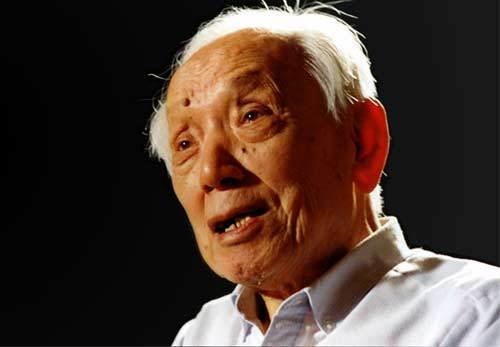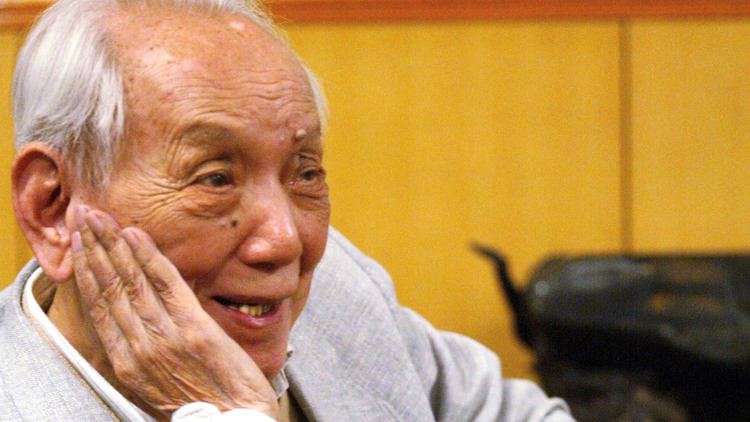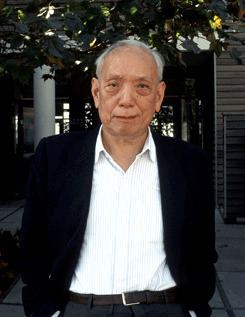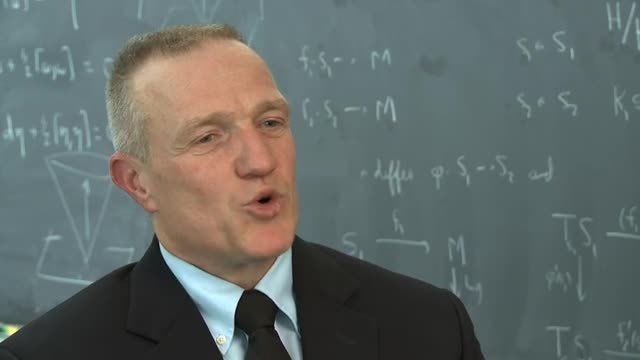Nationality Chinese and American Fields Mathematics Role Mathematician | Name Shiing-Shen Chern | |
 | ||
Institutions Tsinghua UniversityInstitute for Advanced StudyUniversity of ChicagoUniversity of California, BerkeleyNankai UniversityCenter of Mathematical Sciences, Zhejiang University Doctoral students Louis AuslanderThomas BanchoffManfredo do CarmoRobert B. GardnerHarold LevineKatsumi NomizuAlan WeinsteinShing-Tung Yau Books Lectures on Differenti, Riemann‑Finsler geometry, Complex manifolds without p, An Introduction to Riema, Selected Papers II Similar People Shing‑Tung Yau, Friedrich Hirzebruch, Chu Ching‑wu, Stephen Smale, Wilhelm Blaschke | ||
Taking the long view the life of shiing shen chern
Shiing-Shen Chern (; Chinese: 陳省身; pinyin: Chén Xǐngshēn, [tʂʰən.ɕiŋ.ʂən]; October 26, 1911 – December 3, 2004) was a Chinese-American mathematician who made fundamental contributions to differential geometry and topology. He was widely regarded as a leader in geometry and one of the greatest mathematicians of the twentieth century, winning numerous awards and recognition including the Wolf Prize and the inaugural Shaw Prize.
Contents
- Taking the long view the life of shiing shen chern
- Murray gell mann another visit to the institute for advanced study shiing shen chern 71 200
- Early years in China
- In Europe
- Short stay in USA
- First return to China
- USA
- Short visits to China
- Final years
- Research
- Honours and awards
- Publication
- Namesake
- Family
- Transliteration and pronunciation
- References

Shiing-Shen Chern spent nearly a decade at the University of Chicago before moving to University of California, Berkeley, where he co-founded the world-renowned Mathematical Sciences Research Institute in 1982 and was the institute's founding director. In memory of Shiing-Shen Chern, the International Mathematical Union established the Chern Medal in 2010 to recognize "an individual whose accomplishments warrant the highest level of recognition for outstanding achievements in the field of mathematics".

Murray gell mann another visit to the institute for advanced study shiing shen chern 71 200
Early years in China

Chern was born in Xiushui County (秀水縣), Jiaxing, in Zhejiang province. The year after his birth, China changed its regime from the Qing Dynasty to the Republic of China. He graduated from Xiushui Middle School (秀水中學) and subsequently moved to Tianjin in 1922 to accompany his father. In 1926, after spending four years in Tianjin, Chern graduated from Fulun High School (扶輪中學).

At age 15, Chern entered the Faculty of Sciences of the Nankai University in Tianjin, studied mathematics there, and graduated with a Bachelor of Science degree in 1930. At Nankai, Chern's mentor was Li-Fu Chiang (姜立夫), a Harvard-trained geometer. Also at Nankai, he was heavily influenced by the physicist Rao Yutai (饶毓泰). Rao is today considered to be one of the founding fathers of modern Chinese informatics.

Chern went to Beiping (now Beijing) to work at the Tsinghua University Department of Mathematics as a teaching assistant. At the same time he also registered at Tsinghua Graduate School as a student. He studied projective differential geometry under Prof. Sun Guangyuan, a University of Chicago-trained geometer and logician who was also from Zhejiang. Sun is another mentor of Chern who is considered a founder of modern Chinese mathematics. In 1932, Chern published his first research article in the Tsinghua University Journal. In the summer of 1934, Chern graduated from Tsinghua with a master's degree, the first ever master's degree in mathematics issued in China.

Chen-Ning Yang's father—Yang Ko-Chuen, another Chicago-trained professor at Tsinghua, but specialising in algebra, also taught Chern. At the same time, Chern was Chen-Ning Yang's teacher of undergraduate maths at Tsinghua.
At Tsinghua, Hua Luogeng, also a mathematician, was Chern's colleague and roommate.
In 1932, Wilhelm Blaschke from the University of Hamburg visited Tsinghua and was impressed by Chern and his research.
In Europe
In 1934, co-funded by Tsinghua and the Chinese Foundation of Culture and Education, Chern went to continue his study in mathematics in Germany with a scholarship. Chern studied at the University of Hamburg and worked under Blaschke's guidance first on the geometry of webs then on the Cartan-Kähler theory. He obtained his Dr. rer.nat. (Doctor of Science, which is equivalent to PhD) degree in February, 1936. Blaschke recommended Chern to study in Paris.
In August 1936, Chern watched summer Olympics in Berlin together with Hua Luogeng who paid Chern a brief visit. During that time, Hua was studying at the University of Cambridge in Britain.
In September 1936, Chern went to Paris and worked with Élie Cartan. Chern spent one year at the Sorbonne in Paris.
In 1937, Chern accepted Tsinghua's invitation and was promoted to professor of mathematics at Tsinghua. However, at the same time the Marco Polo Bridge Incident (near Beijing) happened and the Second Sino-Japanese War started, Tsinghua was forced to move away from Beijing to west China. Three universities including Peking University, Tsinghua, and Nankai formed the National Southwestern Associated University (NSAU), and was relocated in Kunming, Yunnan province. Chern never reached Beijing. In the same year, Hua Luogeng was promoted to professor of mathematics at Tsinghua.
Short stay in USA
In July 1943, Chern went to the United States, and worked at the Institute for Advanced Study (IAS) in Princeton on characteristic classes in differential geometry. Shortly afterwards, he was invited by Solomon Lefschetz to be an editor of Annals of Mathematics.
First return to China
Chern returned to Shanghai in 1946 to help found the Institute of Mathematics of the Academia Sinica, which was later moved to Nanking (then-capital of the Republic of China). Chern was the acting president of the institute. Wu Wenjun was Chern's graduate student at the institute.
In 1948, Chern was elected one of the first academicians of the Academia Sinica. He was the youngest academician elected (at age 37).
USA
In 1949, Chern returned to the United States, again worked at the IAS. In 1949, Chern became professor of mathematics at the University of Chicago. Coincidentally, Ernest Preston Lane, former Chair at UChicago Department of Mathematics, was the doctoral advisor of Chern's undergraduate mentor at Tsinghua—Sun Guangyuan.
Chern moved to the University of California, Berkeley, in 1960, where he worked and stayed until his retirement in 1979. In 1961, Chern became a naturalized citizen of the United States. In the same year, he was elected member of the United States National Academy of Sciences.
In 1964, Chern was a vice-president of American Mathematical Society (AMS).
Chern retired from Berkeley in 1981. He founded the Mathematical Sciences Research Institute (MSRI) in 1981 and served as the director until 1984. Afterward he became the honorary director of the institute. MSRI now is one of the largest and most prominent mathematical institutes in the world. Shing-Tung Yau was one of his PhD students during this period.
Short visits to China
The Shanghai Communiqué was issued by the United States and the People's Republic of China on February 27, 1972. The relationship between these two nations started to normalise, and American citizens were allowed to visit P.R.China. In September 1972, Chern visited Beijing with his wife. During this period of time, Chern visited China 25 times, of which 14 were to his home province Zhejiang.
Chern founded the Nankai Institute for Mathematics (NKIM) at his alma mater Nankai in Tianjin. The institute was formally established in 1984 and fully opened in October 17, 1985. NKIM was renamed the Chern Institute of Mathematics in 2004 after Chern's death.
Final years
Based on Chern's advice, a mathematical research center was established in Taipei, Taiwan, whose co-operational partners are National Taiwan University, National Tsing Hua University and the Sinica Academia Institute of Mathematics.
Chern was also a director and advisor of the Center of Mathematical Sciences at Zhejiang University in Hangzhou, Zhejiang.
From 2000 to his death, Chern lived in Tianjin, China. Chern died of heart failure at his home in Tianjin in 2004 at age 93.
Research
Chern's work extends over all the classic fields of differential geometry. It includes areas currently fashionable (the Chern–Simons theory arising from a 1974 paper written jointly with Jim Simons), perennial (the Chern–Weil theory linking curvature invariants to characteristic classes from 1944, after the Allendoerfer–Weil paper of 1943 on the Gauss–Bonnet theorem), the foundational (Chern classes), and some areas such as projective differential geometry and webs that have a lower profile. He published results in integral geometry, value distribution theory of holomorphic functions, and minimal submanifolds.
He was a follower of Élie Cartan, working on the 'theory of equivalence' in his time in China from 1937 to 1943, in relative isolation. In 1954 he published his own treatment of the pseudogroup problem that is in effect the touchstone of Cartan's geometric theory. He used the moving frame method with success only matched by its inventor; he preferred in complex manifold theory to stay with the geometry, rather than follow the potential theory. Indeed, one of his books is entitled "Complex Manifolds without Potential Theory". In the last years of his life, he advocated the study of Finsler geometry, writing several books and articles on the subject.
Honours and awards
Chern received numerous honors and awards in his life, including:
Chern was given a number of honorary degrees, including from The Chinese University of Hong Kong (LL.D. 1969), University of Chicago (D.Sc. 1969), ETH Zurich (Dr.Math. 1982), SUNY Stony Brook (D.Sc. 1985), TU Berlin (Dr.Math. 1986), his alma mater Hamburg (D.Sc. 1971) and Nankai (honorary doctorate, 1985), etc.
Chern was also granted numerous honorary professorships, including at Peking University (Beijing, 1978), his alma mater Nankai (Tianjin, 1978), Chinese Academy of Sciences Institute of Systems Science (Beijing, 1980), Jinan University (Guangzhou, 1980), Chinese Academy of Sciences Graduate School (1984), Nanjing University (Nanjing, 1985), East China Normal University (Shanghai, 1985), USTC (Hefei, 1985), Beijing Normal University (1985), Zhejiang University (Hangzhou, 1985), Hangzhou University (1986, the university was merged into Zhejiang University in 1998), Fudan University (Shanghai, 1986), Shanghai University of Technology (1986, the university was merged to establish Shanghai University in 1994), Tianjin University (1987), Tohoku University (Sendai, Japan, 1987), etc.
Publication
Namesake
Family
His wife, Shih-ning Cheng(Chinese: 鄭士寧; pinyin: Zheng Shining), whom he married in 1939, died in 2000. He also had a daughter, May Chu (Chinese: 陳璞; pinyin: Chen Pu), wife of the physicist Chu Ching-wu, and a son named Paul (pinyin: Chen Bolong).
Transliteration and pronunciation
Chern's surname is a common Chinese surname which is now usually spelt Chen. The unusual spelling "Chern" is a transliteration in the old Gwoyeu Romatzyh (GR) romanization for Mandarin Chinese used in the early twentieth century China. It uses special spelling rules to indicate different tones of Mandarin, which is a tonal language with four tones. The silent r in "Chern" indicates a second-tone syllable, written "Chén" in pinyin but in practice often written by non-Chinese without the tonal mark. In GR the spelling of his given name "Shiing-Shen" indicates a third tone for Shiing and a first tone for Shen, which are equivalent to the syllables "Xǐngshēn" in pinyin.
In English, Chern pronounced his name "Churn" (), and this pronunciation is now universally accepted among English-speaking mathematicians and physicists.
